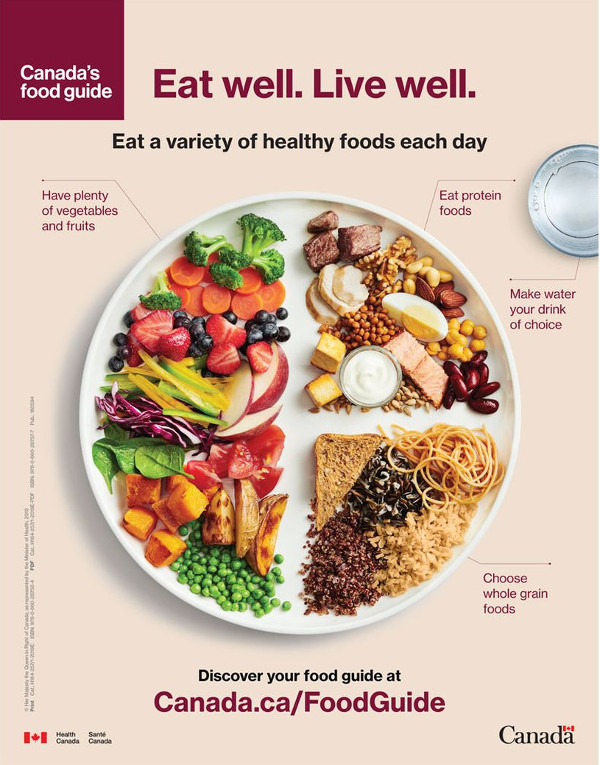You often hear about studies or analyses of the combined results of previous surveys addressing specific dietary and nutrition issues. They call it ‘data mining’. Now, a mammoth new data mining project has produced massive validation for an old dietary maxim: the 5-A-Day rule…
 Last year’s newest edition of Canada’s Food Guide: Just needed the answers
Last year’s newest edition of Canada’s Food Guide: Just needed the answers
to the questions of specifically ‘how much’ and ‘which kinds’ of fruits
and veggies to eat to tie up its message in a bright red ribbon…
Don’t throw out your existing precepts about what constitutes an optimal diet yet… But the latest global analysis of eating habits as they relate to healthy living and longevity might just have simplified and clarified the rules for healthy eating more than any findings in the past century or more. And the results may surprise you.
Seemed too simple to be true?
Scientists, it seems are always looking to ‘decode’ more and more complex relationships between foods and food constituents to find out why certain dietary regimes work against certain diseases and conditions – principally, obesity, heart disease, some cancers, type 2 diabetes, and systemic inflammation – which all seem to work together to threaten healthy living and longer living.
But now, the largest, most inclusive analysis of global eating habits, graphed against world-wide health and longevity figures appears to have validated a simple, old maxim about sensible eating: the ancient and venerable 5-A-Day Rule
What they did
Researchers at the Harvard Medical School and Brigham and Women’s Hospital in Boston looked at pooled data on fruit and vegetable intake and death from 26 studies that included about 1.9 million participants from 29 countries and territories in North and South America, Europe, Asia, Africa and Australia.
Lead Study Author Dr. Dong D. Wang says, “While groups like the American Heart Association recommend four to five servings each of fruits and vegetables daily, consumers likely get inconsistent messages about what defines optimal daily intake of fruits and vegetables such as the recommended amount, and which foods to include and avoid.”
They wanted a definitive answer to the question, “What is optimal?”
What they found
According to an abstract of the study findings, when the digits settled, the team was left with the following main conclusions:
- Intake of about five servings of fruits and vegetables daily was associated with the lowest risk of death. Eating more than five servings was not associated with additional benefit.
- Eating about two servings daily of fruits and three servings daily of vegetables was associated with the greatest longevity.
- Compared to those who consumed two servings of fruit and vegetables per day, participants who consumed five servings a day of fruits and vegetable had a 13 percent lower risk of death from all causes; a 12 percent lower risk of death from cardiovascular disease, including heart disease and stroke; a 10 percent lower risk of death from cancer; and a 35 percent lower risk of death from respiratory disease, such as chronic obstructive pulmonary disease (COPD).
- Not all foods that one might consider to be fruits and vegetables offered the same benefits. For example: Starchy vegetables, such as peas and corn, fruit juices and potatoes were not associated with reduced risk of death from all causes or specific chronic diseases.
- On the other hand, green leafy vegetables, including spinach, lettuce and kale, and fruit and vegetables rich in beta carotene and vitamin C – such as citrus fruits, berries and carrots – showed benefits.
The takeaway
The findings clearly support the latest official recommendations of the American Heart Association and Canada’s Food Guide, to fill your plate with at least 1/2 fruits and veggies for optimal nutrition. (Another quarter of the plate should be occupied by whole grains and whole grain products, and the final quarter should comprise healthy, lean protein.)
Whereas the AHA and the Food Guide don’t offer specific guidelines as to how much of each of those food groups to eat, the new survey strongly supports the consumption of three servings of veggies and 2 servings of fruits daily. It also specified the types of fruits and veggies to eat.
My take
I was shocked – in a good way – at how suitable the cover picture on the latest edition of Canada’s Food Guide (see photo, above, left) could be as a graphic illustration of the AHA’s (and other groups’ and countries’) current dietary recommendations. But I must stress how important it is that some reliable quantification has been defined for how much fruit and veggies, and some specific qualification determined of what kinds of fruits and veggies we should eat.
And let’s not forget how closely the new survey results correspond to the much earlier – and constantly reconfirmed – findings of studies recommending the so-called Mediterranean Diet.
According to the U.S. Centers for Disease Control and Prevention, “Only about one in 10 adults eat enough fruits or vegetables.” Now that the ‘what’ and ‘how much’ questions have been answered, the remaining issue may be how to get us Canadians, Americans and Europeans to get off our spongy duffs and follow the newly quantified recommendations.
~ Maggie J.

